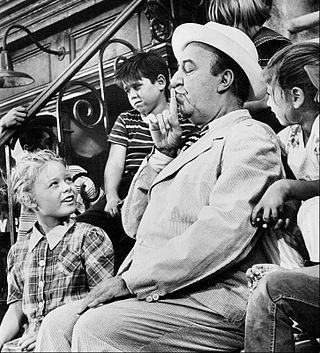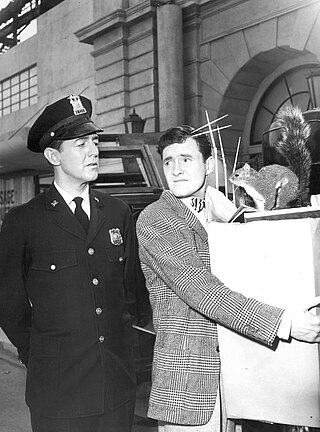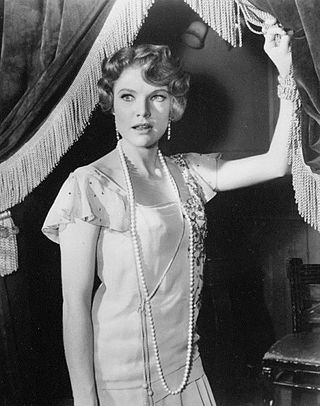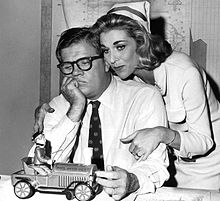
"Where Is Everybody?" is the first episode of the American anthology television series The Twilight Zone and was originally broadcast on 2 October 1959, on CBS. It is one of the most realistic Twilight Zone episodes, as it features no supernatural elements and is based on fairly straightforward extrapolation of science.

"One for the Angels" is the second episode of the American anthology television series The Twilight Zone. It originally aired on October 9, 1959, on CBS television.
"Walking Distance" is episode five of the American television series The Twilight Zone. It originally aired on October 30, 1959. The episode was listed as the ninth best episode in the history of The Twilight Zone by Time magazine.

"A Stop at Willoughby" is episode 30 of the American television anthology series The Twilight Zone. Rod Serling cited this as his favorite story from the first season of the series.

"Mr. Bevis" is episode thirty-three of the American television anthology series The Twilight Zone. It first aired on June 3, 1960 on CBS. This episode is one of only four to feature the "blinking eye" opening sequence, and the first to feature the opening narration which would be used for every episode throughout season 2 and 3. The episode was an unsuccessful television pilot.

"The Trouble with Templeton" is episode 45 of the American television anthology series The Twilight Zone starring Brian Aherne, Pippa Scott and Sydney Pollack. The episode originally aired on December 9, 1960 on CBS.
"Back There" is episode 49 of the American television anthology series The Twilight Zone. It originally aired on January 13, 1961 on CBS, and was the 13th episode of the second season. It was written by series creator Rod Serling and was directed by David Orrick McDearmon. It involves time travel, and stars Russell Johnson, who had appeared in another time-travel episode the previous season.
"The Night of the Meek" is episode 47 of the American television anthology series The Twilight Zone. It originally aired on December 23, 1960, on CBS. It was one of the six episodes of the second season which were shot on videotape in a short-lived experiment aimed to cut costs.
"Mr. Dingle, the Strong" is episode 55 of the American television anthology series The Twilight Zone, and is the 19th episode of the second season. It was one of the many episodes in the second season written by series creator and showrunner Rod Serling, and was directed by German filmmaker John Brahm. The episode originally aired on March 3, 1961 on CBS.

"Static" is episode 56 of the American television anthology series The Twilight Zone. It originally aired on March 10, 1961 on CBS. It was one of the six episodes of the second season which was shot on videotape in a short-lived experiment aimed to cut costs.
"The Midnight Sun" is episode 75 of the American television anthology series The Twilight Zone, first shown in November, 1961.

Twilight Zone: The Movie is a 1983 American science fiction anthology film produced by Steven Spielberg and John Landis. Based on Rod Serling's 1959–1964 television series of the same name, the film features four stories directed by Landis, Spielberg, Joe Dante, and George Miller. Landis' segment is an original story created for the film, while the segments by Spielberg, Dante, and Miller are remakes of episodes from the original series. The film's cast includes Dan Aykroyd, Albert Brooks, Scatman Crothers, John Lithgow, Vic Morrow, and Kathleen Quinlan. Original series cast members Burgess Meredith, Patricia Barry, Peter Brocco, Murray Matheson, Kevin McCarthy, Bill Mumy, and William Schallert also appear in the film, with Meredith assuming Serling's role as narrator.
"Kick the Can" is episode 86 of the American television anthology series The Twilight Zone. It originally aired on February 9, 1962, on CBS.
"Caesar and Me" is episode 148 of the American television anthology series The Twilight Zone starring Jackie Cooper as a ventriloquist. It is not to be confused with a similar episode "The Dummy", starring Cliff Robertson as a ventriloquist.

"In Praise of Pip" is an episode of the American television anthology series The Twilight Zone. In this episode, after learning that his soldier son has suffered a mortal wound in an early phase of the Vietnam War, a crooked bookie encounters a childhood version of his son.
The Twilight Zone is a nationally syndicated radio drama series featuring radio play adaptations of the classic 1959–1964 television series The Twilight Zone. The series was produced for the British digital radio station BBC Radio 4 Extra airing for 176 episodes between October 2002 and 2012. In the United States, it aired on nearly 200 radio stations including WCCO, KSL, KOA, WIND, XM Satellite Radio channel 163 and Sirius XM Book Radio. Most of the stations aired two episodes each week, usually on the weekends and many times back to back.
Syncro-Vox is a filming method that combines static images with moving images, the most common use of which is to superimpose talking lips on a photograph of a celebrity or a cartoon drawing. It is one of the most extreme examples of the cost-cutting strategy of limited animation. The method was developed by cameraman Edwin "Ted" Gillette in the 1950s in order to simulate talking animals in television commercials. Gillette filed the technique on February 4, 1952, and obtained patent #2,739,505 on March 27, 1956.
"Young Man's Fancy" is episode 99 of the American television anthology series The Twilight Zone.
"Cavender Is Coming" is episode 101 of the American television anthology series The Twilight Zone. It originally aired on May 25, 1962 on CBS.
"Come Wander with Me" is the final episode to be filmed of the American television series The Twilight Zone. This episode introduced Bonnie Beecher in her television debut.








